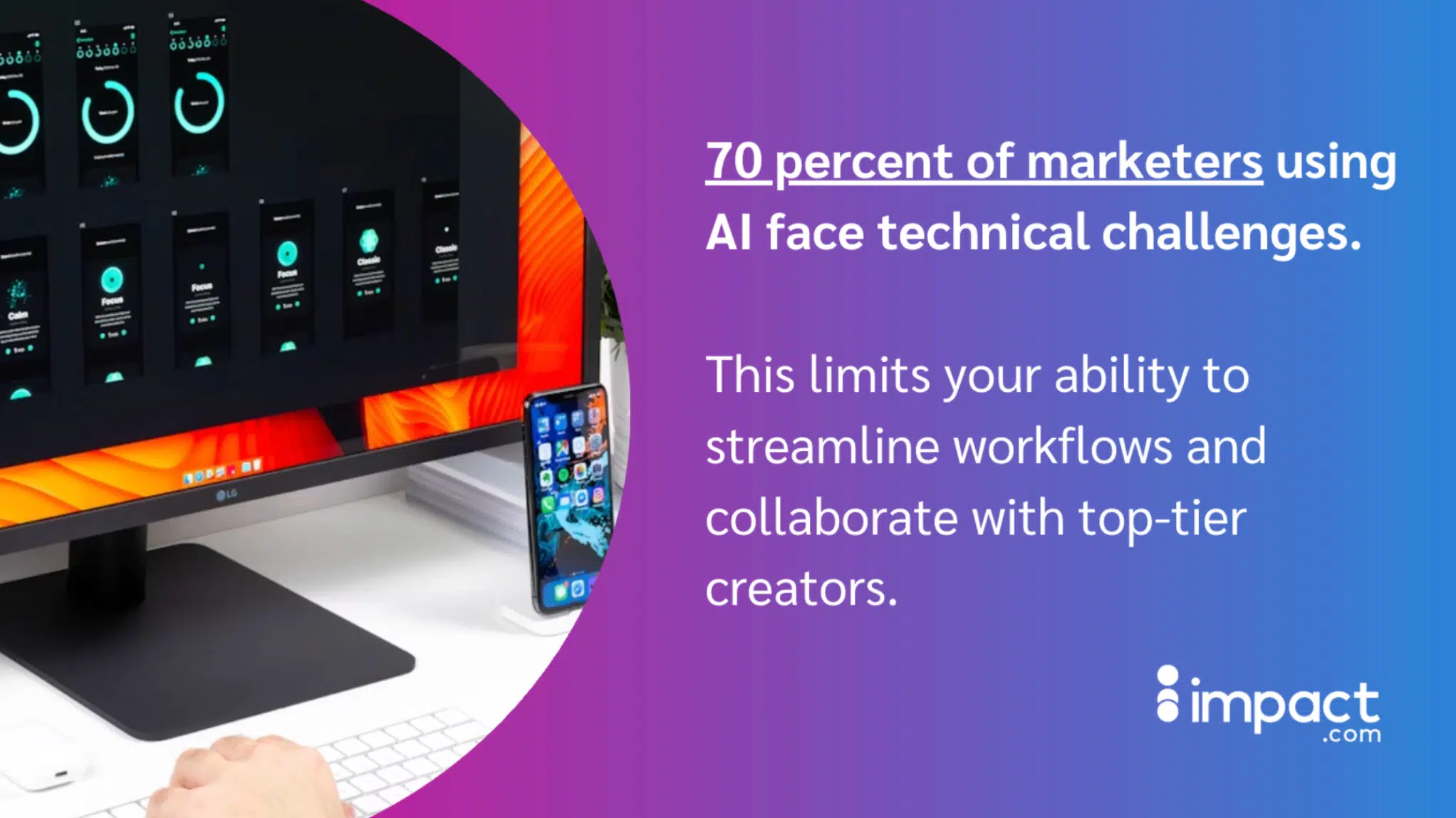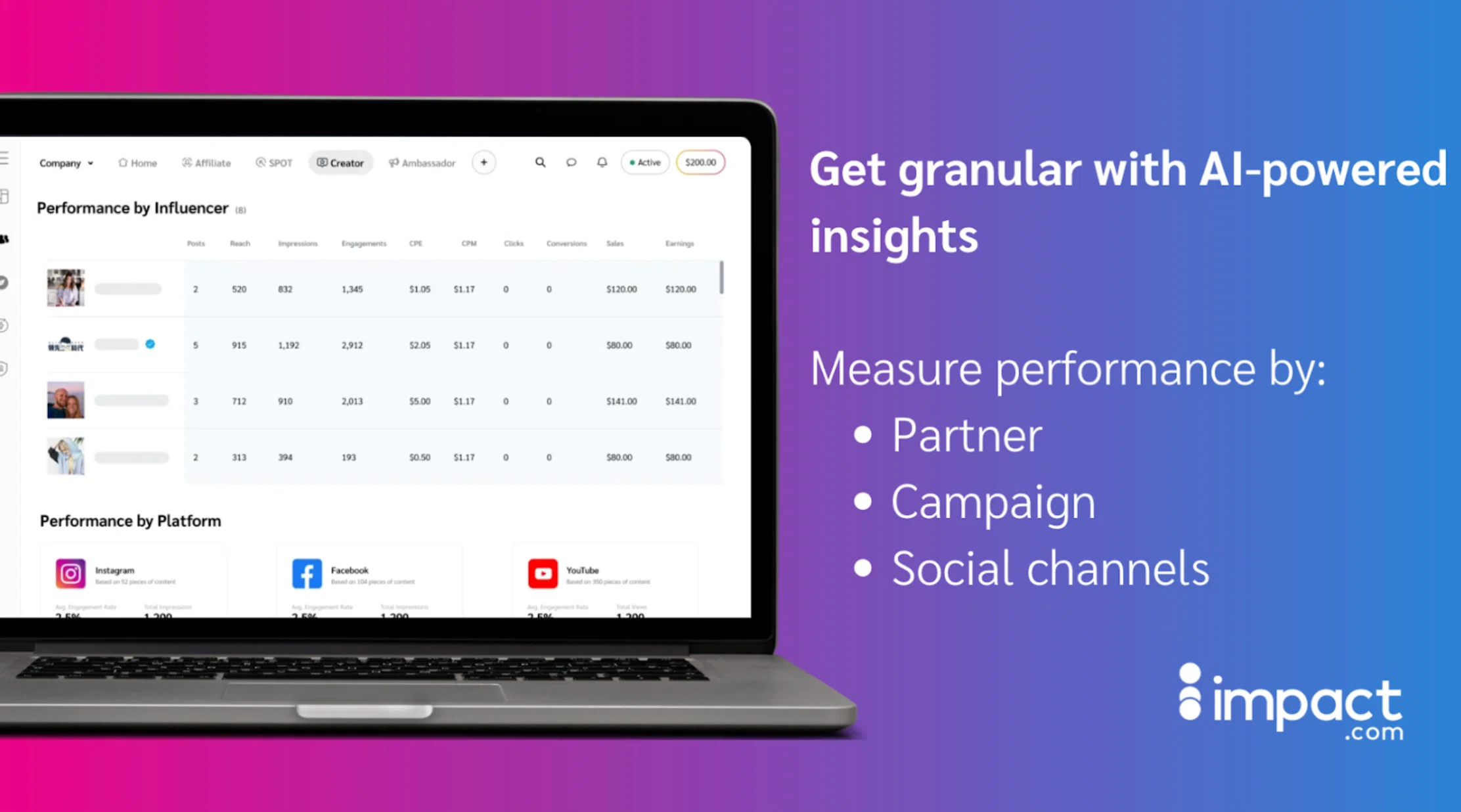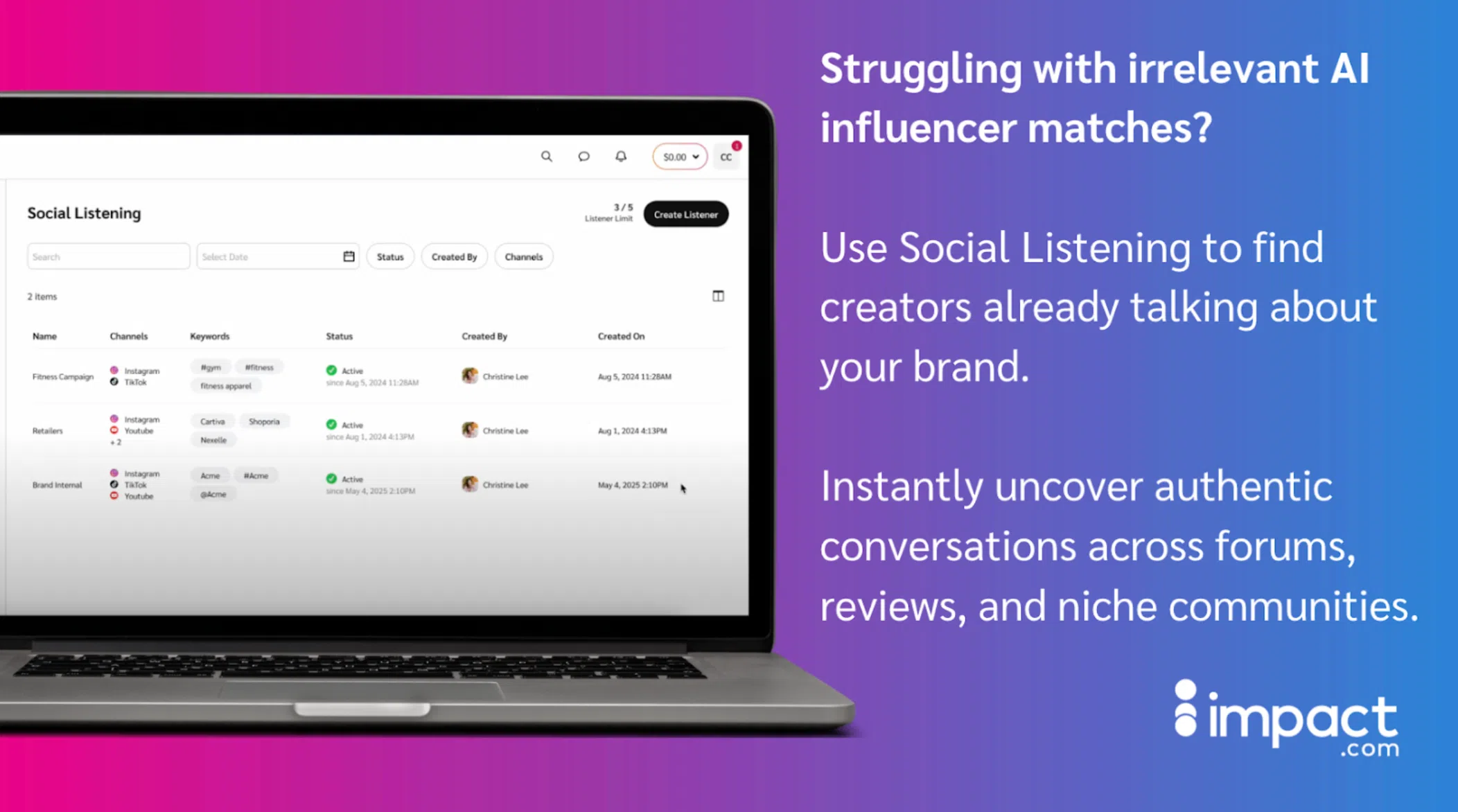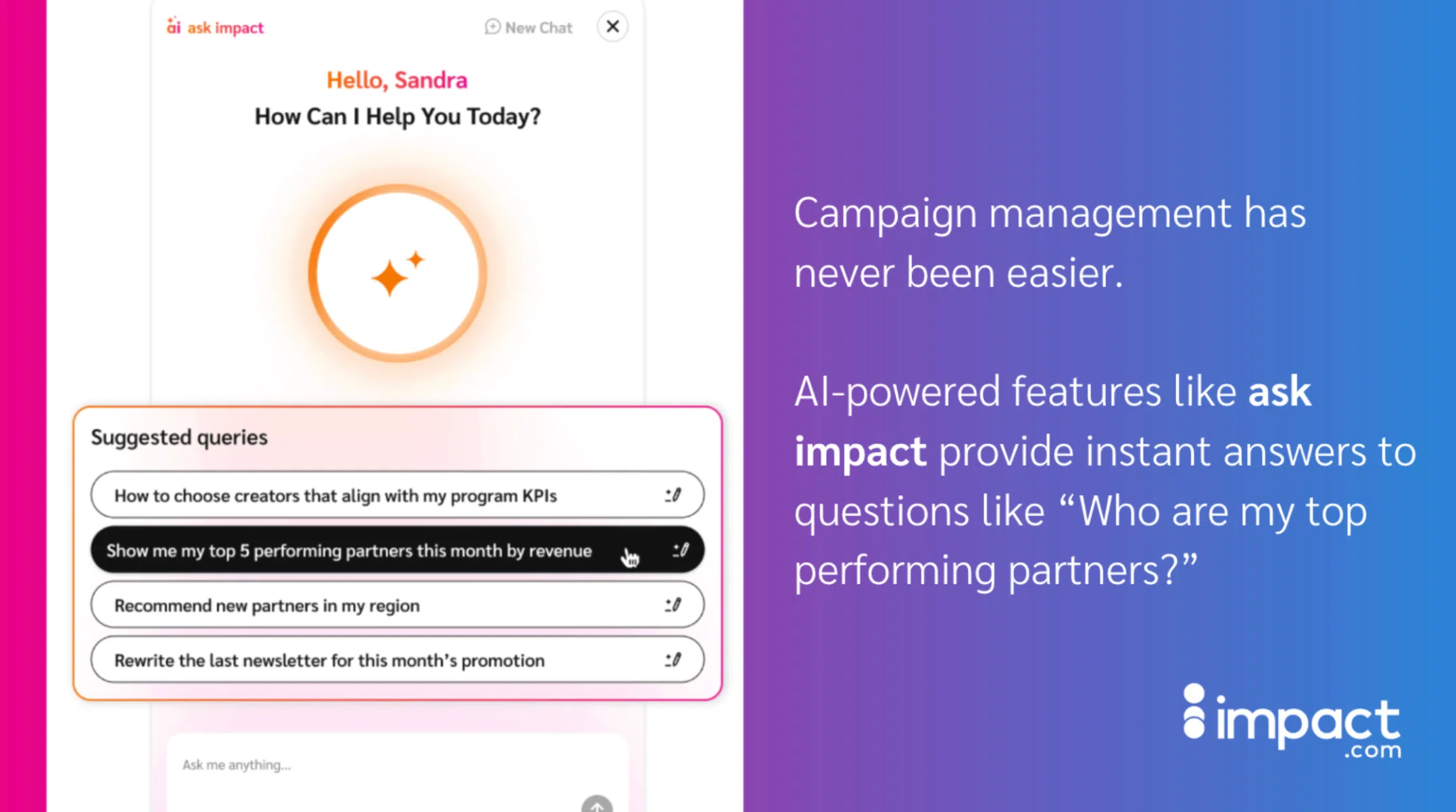You implemented AI tools to solve your influencer marketing challenges. The promise was compelling: find better creators faster, detect fraud automatically, and get clearer return on investment (ROI) insights.
Instead, you’re managing more moving pieces than before. Your morning routine now includes checking multiple platforms to understand campaign performance. Those creators with stellar AI scores aren’t driving the sales you expected. And despite having “smarter” discovery tools, you’re still spending significant time filtering through suggestions that don’t fit your brand.
Sound familiar? You’re experiencing what 70 percent of marketers face when using AI for influencer marketing—technical challenges and limitations that complicate rather than streamline workflows.
The issue isn’t that AI technology doesn’t work. It’s that fragmented solutions create new problems while solving old ones.

The real AI influencer marketing problems nobody’s talking about in 2025
AI influencer marketing saves time and detects fraud, but it can also introduce new issues that weren’t part of the original pitch.
The reality? Many marketers find AI creates the opposite effect. Brian Klais, founder of URLgenius, puts it simply: AI should act as a “super virtual assistant, not a workflow disrupter. It’s a tool that processes information to deliver relevant recommendations, like where to focus your time or which products to promote next.” For many marketers, this isn’t the case.
Focusing only on polished dashboards and engagement rates often leads to missed opportunities and mismatched partnerships.
Let’s explore the top three problems marketers face with AI:
- Integration headaches
- A focus on vanity metrics
- A flood of irrelevant partner matches

Problem 1: Integration headaches with AI platforms create chaos across campaigns
When systems don’t connect, neither do the insights.
You could end up buried in conflicting dashboards instead of focusing on the relationships that drive results.
These relationships are the heartbeat of partnerships, as echoed by Todd Crafword, Co-Founder at impact.com. Instead of causing roadblocks, Crawford says, “Technology like AI should help us protect and prioritize those relationships by giving us back time and clarity.”
Disjointed AI tools
AI tools often have separate systems for:
- Influencer discovery
- Fraud detection
- Campaign management
- Reporting
This fragmented approach creates siloed data and disjointed workflows across multiple AI platforms.
Data silos
Each AI marketing tool stores data differently. Without a unified platform, you can’t get a holistic view of your campaign life cycle or track performance across channels, resulting in attribution and measurement chaos in AI campaigns.
Unclear ROI
Multiple systems make it hard to understand which activities drive revenue, leading to poor resource allocation and unclear ROI.
Problem 2: The “good metrics, bad results” trap keeps brands stuck in vanity metrics
High engagement scores don’t always translate to sales.
Numbers alone can mislead you and hide weak partnerships that cost you conversions.
Obsession with numbers
AI algorithms often rank creators by follower counts and engagement rates, ignoring storytelling skills or subject‑matter expertise.
This overemphasis on metrics in influencer marketing creates problems, such as:
- Superficial impact: Focusing solely on follower counts or likes often prioritizes influencers with broad but shallow reach, ignoring those with genuine audience trust and engagement.
- Misaligned partnerships: Metrics-driven decisions can lead to collaborations with influencers who don’t align with your brand values or messaging, reducing campaign authenticity.
- Inflated costs: High engagement numbers can result in inflated influencer fees, even if the actual ROI or audience conversion is low.
- Neglecting niche audiences: Smaller, niche influencers who may resonate deeply with a specific target audience are often overlooked in favor of larger accounts.
- Short-sighted focus: Metrics-centered strategies can prioritize quick results over building long-term connections with audiences, limiting sustainable brand growth.
Later’s research signals a shift beyond vanity metrics to focus on outcomes and ROI.
High scores, low sales
Even creators with a perfect AI score might not boost your sales. Why? Because AI can’t always grasp the subtle ways humans connect and persuade. Klais makes the case for blending the human touch with AI, adding, “I cannot outsource my voice, my personality, who I am through AI.”
Another reason not to trust perfect AI scores as your only truth source: Nano-influencers (>15k followers) can deliver standout engagement rates of 6.15 to 6.76 percent even though they may not rank high on follower counts.
Audiences are unique and complex. They connect with creators on a human level, not just through numbers. Your approach should mirror their behavior.
Authenticity overlooked
Metrics don’t reveal how well a creator connects with their audience through human emotion and connection.
AI-driven sentiment analysis enables you to review audience comments more effectively to:
- Evaluate tone and comment quality
- Gain deeper insights for a better brand fit
- Ensure partner authenticity
Problem 3: Too many irrelevant matches from AI influencer discovery platforms
AI platforms flood you with recommendations you shouldn’t pursue. Poor matches overwhelm your workflow and bury the creators who actually align with your brand values.
Generic recommendations
AI influencer discovery platforms can bombard you with creators who look good on paper but clash with your brand voice and values. You end up with partnerships that feel forced and inauthentic.
Bias and echo chambers
AI models learn from historical data and repeat the same biases back to you. Your recommendations skew toward identical demographics and categories, blocking diverse voices from your radar and exposing you to brand safety risks.
Flooded dashboards
Your dashboard overflows with endless partner suggestions that eat up hours of your day. Instead of discovering hidden gems, you’re drowning in irrelevant profiles that slow your campaigns to a crawl.
Meanwhile, the authentic voices and diverse creators who could actually drive results get buried in the noise. Without smarter filtering, you’ll keep missing the perfect brand fits hiding right in front of you.
The essential AI toolkit: Features that help you scale
To overcome these challenges, invest in a cohesive toolkit that combines automated precision with human insight using the best AI features.
Here’s the toolkit at a glance:
- Unified AI-powered partnership platform
- Deep creator vetting tools and post-campaign monitoring
- AI-powered Social Listening tools
Brand tip: Crawford advises you to take charge when implementing these tools, “You can let AI help you, but don’t let AI run wild.”

Problem: Integration headaches → Solution: A unified AI-powered partnership platform
Instead of juggling multiple dashboards, look for platforms that consolidate everything into a single interface. A unified system handles discovery, fraud detection, and reporting from one place, eliminating the daily dashboard shuffle.
Built-in partner marketplace
The best platforms include built-in creator marketplaces with pre-vetted partners. You can filter by follower size, niche, and compensation preferences without building relationships from scratch or hunting across separate platforms.
Contextual searching: Go beyond basic keyword searches with AI-powered tools that understand your brand’s unique needs.
Instead of simply searching for “fitness influencers,” a contextual search can identify influencers whose content aligns with your brand values, such as promoting sustainable activewear or inclusive wellness. This ensures you discover partners who truly resonate with your audience.
Monitor brand safety
Social Monitoring tools leverage AI for:
- Compliance with ad disclosures
- Brand-safe language in content
- Machine learning to safeguard policies and protect brand reputation
Built-in fraud detection mitigates brand safety risks while maintaining brand alignment across all creator partnerships.
See the big picture
Get granular with your data and filter by:
- Campaign
- Partner type
- Social channel
These insights make it easy to determine high-performing strategies and make data-driven decisions to optimize your campaign and ROI.
This unified view also resolves attribution and measurement chaos by centralizing all performance data in one dashboard. It makes it easier to track a campaign’s life cycle without jumping between AI marketing tools.

Problem: Good metrics, bad results → Solution: Deep vetting tools and post-campaign monitoring
Surface‑level metrics can be easily inflated.
A comprehensive influencer discovery process should include AI tools and your judgment to assess:
- Partner quality
- Brand fit
- Authenticity
Deep vetting tools
Move beyond follower counts by analyzing content quality and brand alignment.
AI-powered Chrome extensions help you discover and vet creators while browsing social media. These tools reveal audience insights, post activity, and similar partners.
Quickly assess creative quality and brand fit to overcome common AI challenges and improve your influencer discovery.
Post-campaign monitoring
The work doesn’t end once content goes live.
Analyzing results shows:
- What worked
- Areas for improvement
- How to refine your campaign
Automated wrap reports generate presentation-ready summaries in seconds. Track performance, engagement, and top creators with centralized metrics and AI-powered insights.
These reports make it easier to spot winning strategies and give stakeholders clear, data-driven justification for decisions.
Problem: Too many irrelevant matches → Solution: AI-powered Social Listening
When AI influencer discovery platforms flood you with irrelevant matches, Social Listening tools cut through the noise. Here’s how:
Find relevant creators already talking about your brand
Social Listening covers forums, review sites, niche communities, and private messaging apps to reveal authentic brand conversations.
AI tools like this are also bidirectional, as Klais reveals, helping creators scale product discovery in less time. Klais adds that “It can also help the brand to identify and discover the creators that are already proving themselves.”

Spot diverse voices
Contextual sentiment analysis detects emotions like excitement or frustration, helping you uncover creators across different demographics and categories.
Discover authentic advocates
Track hashtags and mentions to find genuine fans who already use and love your product. This approach reduces the AI bias when identifying influencers.
These authentic voices resonate with audiences, resulting in:
- Strong brand sentiment
- Cohesive messaging
- Better engagement
AI chatbots: Getting answers without the data dig
The next evolution in partnership platforms involves conversational AI that lets you query your data naturally. Instead of building complex reports or navigating multiple dashboards, you can simply ask questions in plain English and get immediate insights.
These AI assistants handle queries like:
- “Which partners drove the highest conversion rates last quarter?”
- “What are the top-performing strategies in my industry?”
- “Can you recommend partners similar to my best performers?”
- “How do I optimize my current campaign setup?”
The advantage goes beyond convenience. When you can generate charts and comparisons on demand, you can identify winning strategies faster and provide stakeholders with data-driven justification for budget decisions.
Tools like ask impact (built into impact.com) represent this approach, letting you have natural conversations with your partnership data rather than wrestling with traditional reporting interfaces.

FAQs
The biggest challenges with using AI for influencer marketing are fragmented platforms, an overemphasis on “vanity metrics” that lead to poor results, and too many irrelevant partner recommendations. Siloed platforms can cause technical and integration headaches, hindering your ability to streamline workflows. On their own, metrics like follower counts and engagement rates don’t guarantee sales or authentic partnerships, which often leads to missed opportunities and mismatched collaborations. Finally, a flood of generic and irrelevant recommendations can waste time and make it difficult to find partners who truly align with your brand’s values and voice.
Good AI tools go beyond basic discovery functions by providing data-rich profiles, content analysis, and sentiment insights. They should offer predictive performance features that show you which creators are most likely to drive a high ROI. Look for a unified platform that consolidates data, as this helps resolve attribution and measurement issues that come from using multiple systems. Ultimately, if your tools are working, you should be able to justify your decisions with clear, data-driven metrics.
When AI recommendations consistently fail, it’s a clear sign you need to rebalance the technology with your own human judgment. While algorithms can process data efficiently, they often prioritize vanity metrics that don’t always translate to sales. You should look for platforms that include contextual analysis tools to assess factors AI often misses, such as authenticity, brand fit, and a creator’s unique voice. By combining automated insights with your own strategic expertise, you can make smarter decisions and not let the AI run unmonitored.
To maintain authenticity, you need to avoid the “authenticity paradox” where content feels AI-optimized but lacks genuine human emotion and connection. The best way to do this is to use AI-powered Social Listening tools to find creators who are already genuine fans of your brand. These tools help you discover organic advocates across forums, review sites, and niche communities. This approach reduces AI bias and ensures your campaigns feature diverse and authentic voices that resonate deeply with their audience.
Choose an all-in-one platform that unifies all your AI tools in a single place. Look for a platform with AI-powered Social Listening to find organic advocates who are already talking about your brand. You should also prioritize platforms that include deep vetting tools, like Chrome extensions, that allow you to assess content quality and brand fit in real-time. A centralized marketplace is also essential for fixing integration headaches and streamlining the discovery process.
Your new co-pilot: Using AI to scale your influencer program
AI influencer marketing has transformed influencer marketing into a sophisticated, data‑driven discipline. It has also introduced new challenges, from platform fragmentation to perfect scores that don’t consider authenticity.
Here’s how to use AI more strategically:
- Unified platforms: Consolidate your tech stack with an all-in-one solution that covers everything from discovery to reporting, giving you a comprehensive campaign view without the clutter.
- Deep vetting tools: Use AI tools such as Chrome extensions to analyze content quality and brand alignment for simple, effective influencer vetting.
- AI-powered Social Listening: Identify authentic advocates talking about your brand to create campaigns that truly resonate with your audience.
Check out more content here:
- The Partnership Economy Podcast: Establishing trust in the era of AI-powered partnerships
- Moving beyond awareness: How creators drive conversions through social commerce and affiliate programs (blog)
- Ultimate guide to influencer marketing (ebook)
- Semrush Success Story: From Legacy System to Modern Partner Hub (video)
- Beyond promotion: How creators add value through authentic affiliate partnerships (blog)







